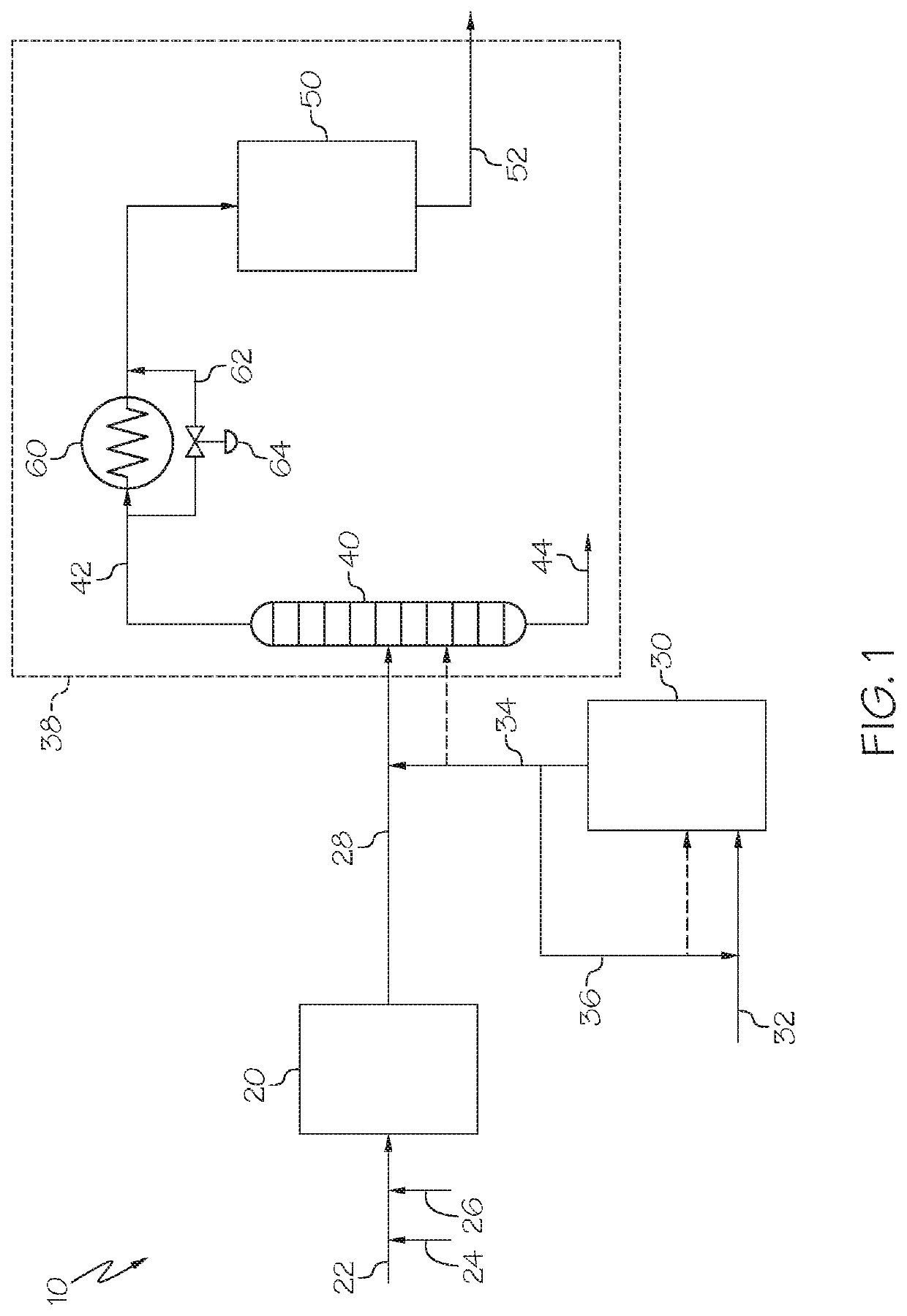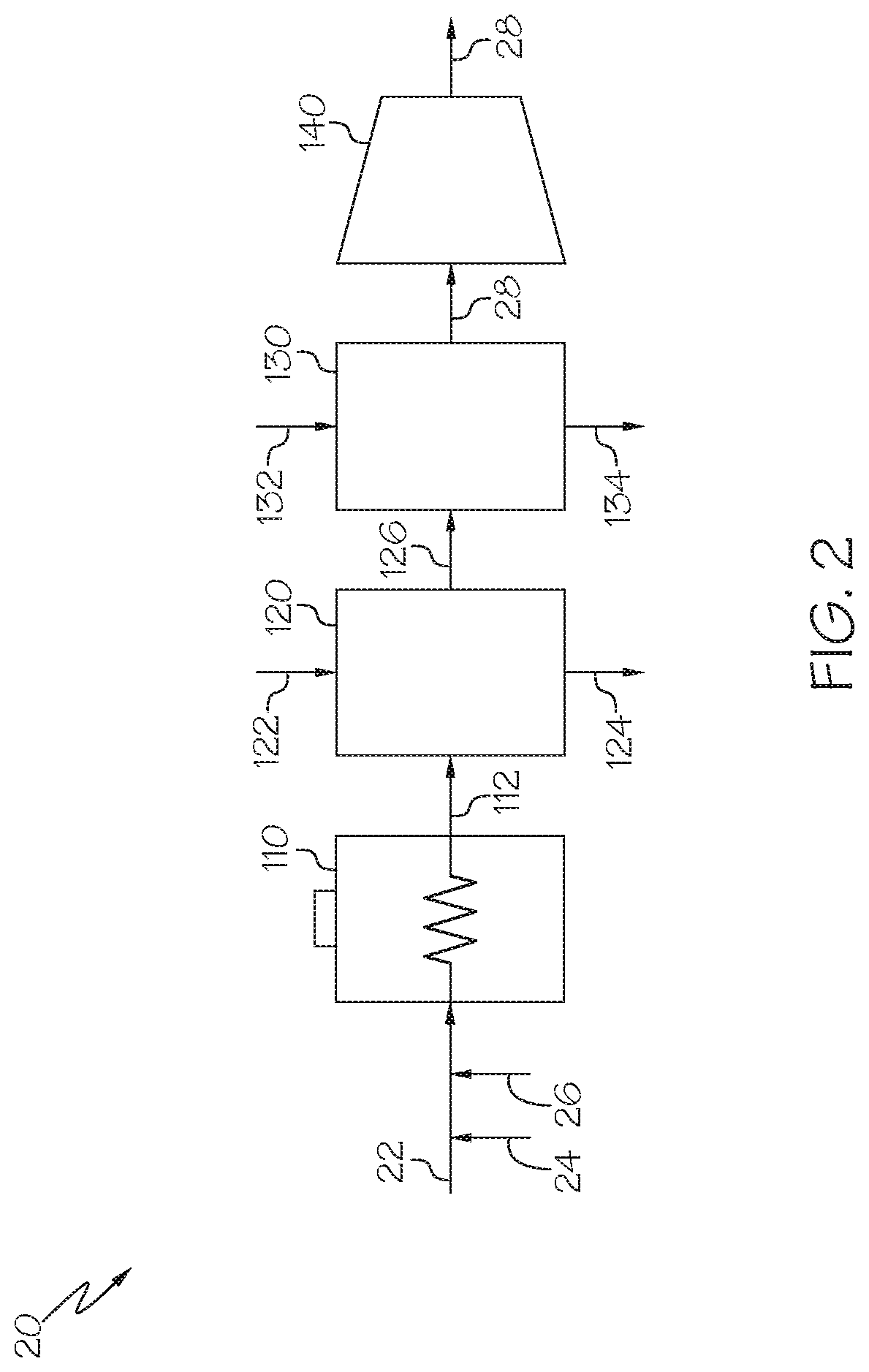Methods for operating acetylene hydrogenation units in integrated steam cracking and fluidized catalytic dehydrogenation systems
a technology of acetylene hydrogenation and hydrogenation feed, which is applied in the direction of physical/chemical process catalysts, gaseous mixture working up, metal/metal-oxide/metal-hydroxide catalysts, etc., to achieve the effect of reducing the selectivity of olefins, increasing the activity of hydrogenation catalysts, and increasing the hydrogenation of olefin products in hydrogenation feed
- Summary
- Abstract
- Description
- Claims
- Application Information
AI Technical Summary
Benefits of technology
Problems solved by technology
Method used
Image
Examples
example 1
n and Analysis of FCDh Effluent
[0106]In Example 1, an FCDh effluent was produced and analyzed for composition with respect to C3+ compounds and C3− compounds. The propane dehydrogenation was carried out in a modified Davison Circulating Riser (DCR) pilot unit, in which in-situ fuel combustion is carried out in the regeneration section. Approximately 4100 grams of a supported Ga-Pt catalyst was loaded in the circulating system and about 90 g of the catalyst was calculated to be in the reactor at any given time. The inlet temperature to the riser (reactor) was controlled at 630° C. and the pressure was set to a gauge pressure of 90 kilopascals (kPa) (13 psig or absolute pressure of 191 kPa / 27.7 psia). High purity propane was injected into the system to achieve a weight hourly space velocity (WHSV) of propane around 3.5 per hour. Nitrogen (N2) was co-fed into the system mostly as a carrier gas of catalyst. The partial pressure of propane was around a gauge pressure of about 30 kPa (4.3...
example 2
of Acetylene Hydrogenation Unit for Integration of FCDh and Steam Cracking
[0109]An empirical model well practiced for acetylene hydrogenation units is used for evaluating changes in the Delta T of the first hydrogenation reactor and changes in the overall ethylene selectivity of the acetylene hydrogenation unit that occur upon a sudden loss of FCDh stream from an integrated FCDh and Steam Cracking System in which where a portion of cracked gas and a portion of the FCDh effluent are combined and separated with the hydrogenation feed fraction fed to the acetylene hydrogenation unit 50. The sudden loss of the FCDh stream to the integrated FCDh / steam cracking system can be simulated by comparing the Delta T of the first hydrogenation reactor and overall ethylene selectivity of the hydrogenation unit for the combined hydrogenation feed (e.g., the C3 / C3− portion of the FCDh effluent and the C3 / C3− portion of the cracked gas) to the Delta T of the first hydrogenation reactor and overall et...
example 3
of Acetylene Hydrogenation Unit for Integration of FCDh and Steam Cracking—Acetylene Conversion Split 95:5:0
[0116]For Example 3, the operation of the acetylene hydrogenation unit is modeled based on the separation system and acetylene hydrogenation unit having an FEDP configuration and an acetylene conversion split between the Reactor A, Reactor B, and Reactor C of 95:5:0, which may be a more conservative approach to operation in order to decrease the probability of producing out of specification product streams having an acetylene concentration in the hydrogenated effluent greater than the threshold acetylene concentration. The modeling is performed according to the method of Example 2 except that the acetylene conversion split between Reactor A, Reactor B, and Reactor C is set at 95:5:0. All other variables and assumptions are the same as in Example 2. The modeling results for Example 3 are provided below in Table 5.
TABLE 5Modeling Data for Example 3 - Acetylene Conversion Split 9...
PUM
| Property | Measurement | Unit |
|---|---|---|
| outlet temperature | aaaaa | aaaaa |
| temperatures | aaaaa | aaaaa |
| temperature | aaaaa | aaaaa |
Abstract
Description
Claims
Application Information
 Login to View More
Login to View More - R&D
- Intellectual Property
- Life Sciences
- Materials
- Tech Scout
- Unparalleled Data Quality
- Higher Quality Content
- 60% Fewer Hallucinations
Browse by: Latest US Patents, China's latest patents, Technical Efficacy Thesaurus, Application Domain, Technology Topic, Popular Technical Reports.
© 2025 PatSnap. All rights reserved.Legal|Privacy policy|Modern Slavery Act Transparency Statement|Sitemap|About US| Contact US: help@patsnap.com



